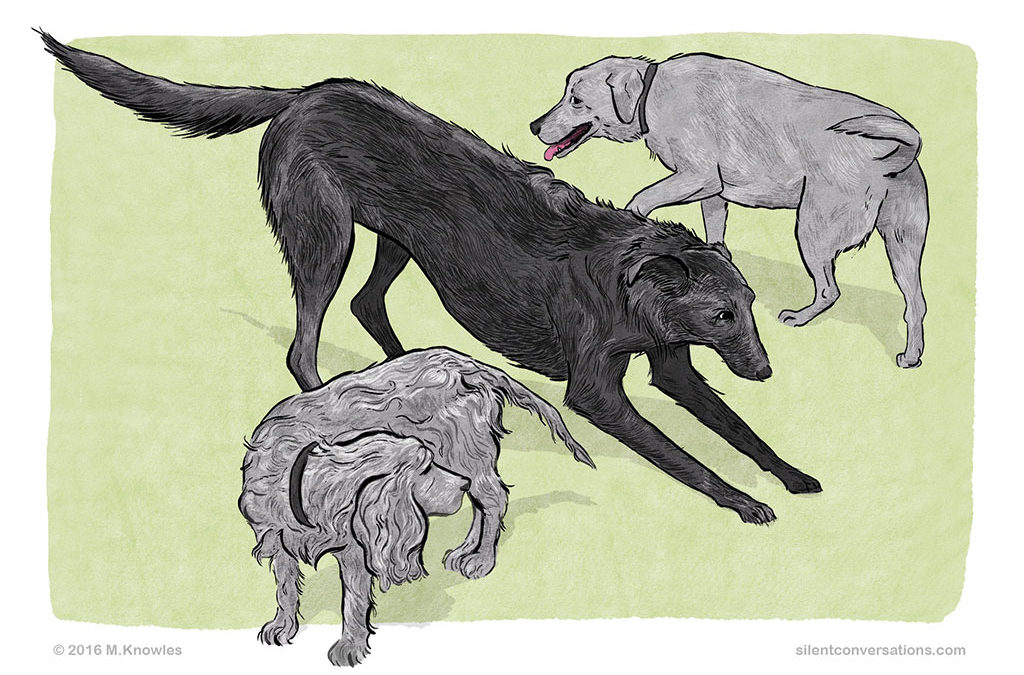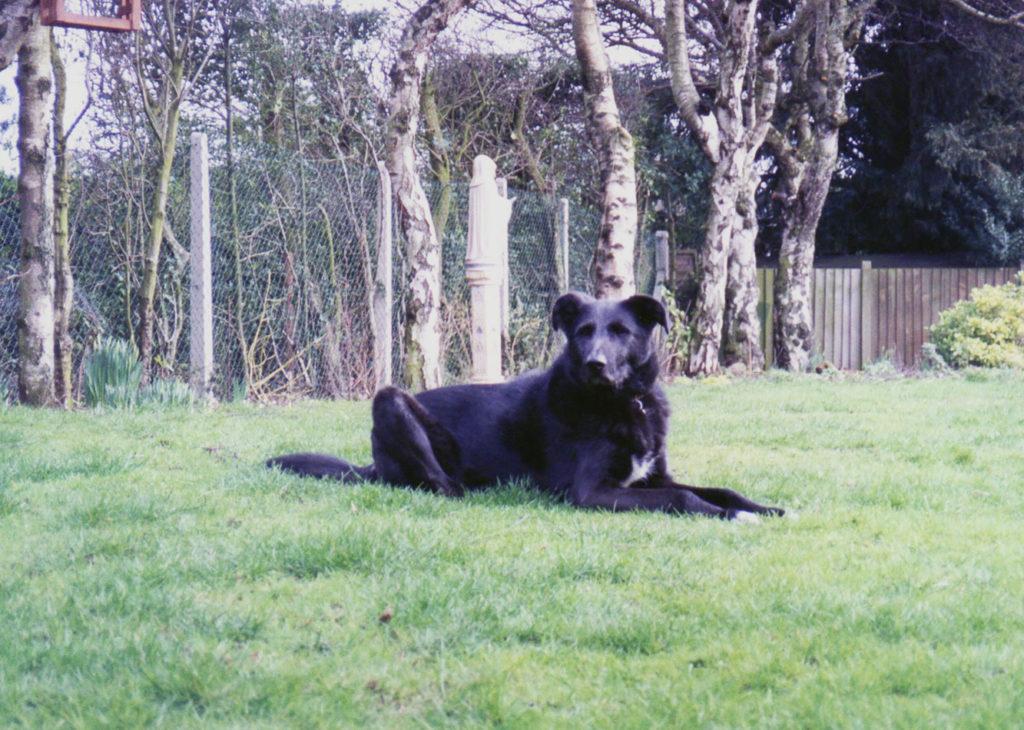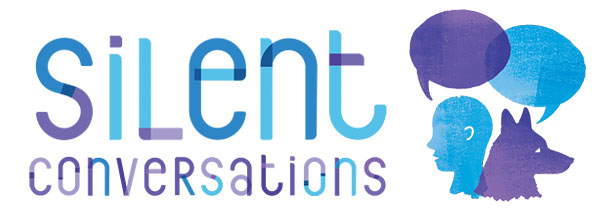
Splitting behaviour in dog communication
Splitting behaviour in dog communication
Some years ago “Gentleman” Gus joined my family. He was a lovely, large mixed breed – probably German shepherd, collie plus other “unknowns”- who had spent far too many of his eight or nine years in rescue kennels and was labelled as dog aggressive. Happily for him and other residents of the shelter, the manager took part in a Sheila Harper course, where she learned (among other things) how dogs communicate and use body language. Applying this to the way animals were assessed and rehabilitated in the shelter changed so much for the dogs in her care, and, by the time Gus and I met, he was well on his way to becoming a first rate canine ambassador.
Dogs use a range of behaviours when relating to us as well as to other animals. I wonder whether you ever spend time watching a group of dogs at play? It can be very informative, entertaining and, for those who have some knowledge of canine communication, occasionally it can be rather worrying.
Often it may look like our pets are having great fun, but, depending on various factors, including personalities, skills and experience of the participants, over exuberant play which goes on for too long can present the perfect opportunity for a dog to learn how to bully or perhaps further develop that tendency. If the activity is a regular occurrence, not only does the bully get more proficient but the dog who is being “picked on” may well become fearful and perhaps start to display aggression to ward off the attention of any other dog.
It is not uncommon to see a couple of dogs engaged heavily in play and perhaps a third one that is hovering in the vicinity, occasionally diving in to the melee. For those not familiar with canine communication, it is easy to assume that they are having a good time; just being dogs. Even the most loving owners may miss distress signals and adrenalin driven pushiness that is on display right in front of them. Fortunately, dogs are much better at assessing situations, and that third dog may well be doing his or her best to bring the interaction to a safe conclusion.

“Gentleman” Gus enjoying recreational time in the garden. © 2016 Marilyn Aspinall
Gus often came with me on group walks, where his good social skills helped maintain a generally peaceful atmosphere. On one memorable occasion, the established group of dogs was joined by a ten month Labrador. He was allowed off lead almost from the outset and, with typical puppy ways, rushed around introducing himself to everyone. The mature dogs largely ignored him and got on with their walk but a fourteen month Cocker spaniel responded to his overtures and they began to play. This went on for several minutes with noise and energy levels rising. Both owners put their dogs on lead, but the lab constantly pulled to get to the spaniel so his owner unleashed him. The spaniel owner did likewise and the wrestling and barking kicked off again. Once more the adolescents went back on lead for a short time before they were set free to play a third time.
It was evident that the spaniel was not enjoying this degree of rough and tumble, but his owner did not seem to realise his dog was asking for help to get him out of the situation. I was aware that Gus had been observing the youngsters for a little while, and he clearly decided that enough was enough. He calmly and slowly walked across to the wriggling, squealing pair and, picking his moment as they briefly drew apart, he bent forward so that he was between them, tucked his head between his forelegs and placed the top of his skull parallel to and almost touching the ground, forming a most effective barrier. He remained in this ungainly position for several seconds as the pair of youngsters looked on for a moment then turned away. Gus stood up and the lab bounced towards the spaniel again but Gus just shifted his position slightly, pup thought better of it and ambled back to his owner.
For the remainder of the walk, the lab and spaniel were kept on lead and well away from each other. If Gus thought play time was over, who were we to argue?
Previously, I had seen videos of dogs using splitting up to diffuse potentially explosive situations and had assumed that the action was always done at speed. In fact, I remember my lurcher, Jep, dashing between a visiting Jack Russell terrier and our tiny, blind cat, which literally stopped the J.R. in his tracks and prevented a chase up the garden developing (as well as maintaining feline dignity!). Seeing Gus adapt the technique to suit the relative size and situation of these two adolescents was quite remarkable and achieved the desired result with no fuss.
Aren’t dogs amazing? They have a huge range of abilities and can teach us so much if we are prepared to learn.
© 2016 Marilyn Aspinall
Marilyn Aspinall
Author
Dogs have been much loved members of my family for around fifty years but it was only in the mid 1990s, when street stray Tanna arrived (full of fears and phobias) that I came to realise you could not simply apply obedience training to combat anxiety and stress based behaviour. Looking for other ways to help this neurotic, hyperactive young lady, I attended a seminar hosted by Sheila Harper which introduced me to the concept of canine communication and Calming Signals. Subsequently, I became a member of Sheila’s “team” and, since around 2004, have supported her endeavours, and those of colleague Winny Boerman, to educate dog owners and people working with dogs to attain a greater understanding of the canine species.
Over the years, helping on courses and seminars has given me the chance to enjoy observing and getting to know a great many fantastic dogs (plus their owners!) while extending and developing my own knowledge. It has been a privilege to see people deepen and, in some instances, repair relationships with their dogs as a result of seeing things from the canine point of view so that they work with their dog rather than depend upon commands and control.
Employing this ethos has enabled me to reach a good understanding of Jorge, the eight year old flat coated retriever who is my current canine companion. He was quite a troubled boy when he first came to live with me four years ago and, given the natural sensitivity and excitability of the breed, initially had me wondering what I had let myself in for. However, his endearing personality always came through and, with mutual understanding and respect, a rewarding partnership has evolved.
It is my hope that many more people come to enjoy similar outcomes through owners and carers learning to appreciate their dogs’ silent conversation.
